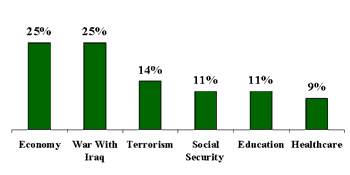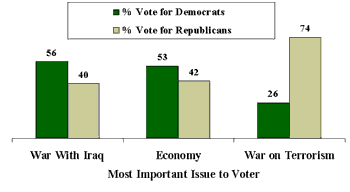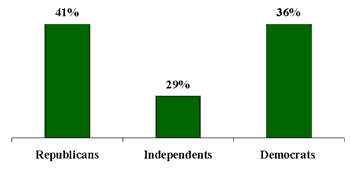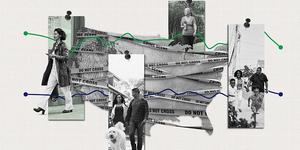GALLUP NEWS SERVICE
PRINCETON, NJ -- The latest CNN/USA Today/Gallup Poll, conducted Oct. 3-6, shows that economic conditions and the possibility of war with Iraq are the most important issues influencing voters -- an equal number of voters, 25%, cite each. Terrorism is ranked third, mentioned as the most important issue in their vote for Congress, by 14% of likely voters, followed by Social Security (11%), education (11%), and healthcare (9%). When asked which party would do a better job of dealing with the issue mentioned by the respondent, 42% of likely voters say the Democrats and 41% say the Republicans. This one-point lead is identical to the lead Democrats enjoy in the generic ballot, which asks respondents which party's candidate they will vote for in the election. Among likely voters, 48% say Democrats, 47% Republicans.
| Most Important Issue Influencing Vote for Congress |
 |
| Oct 3-6, 2002 |
The Economy and Iraq -- Democratic Issues?
In recent days, there has been much public discussion as to which issue, the economy or the possibility of war with Iraq, will be decisive in the November elections. Polls show that Americans tend to rate congressional Republicans as better able to deal with issues of foreign policy, including the war on terrorism. At the same time, Americans tend to rate Democrats as better able to deal with domestic issues such as Social Security, education and healthcare. Thus, it is generally assumed that if voters are mostly concerned about a possible war with Iraq, they will be more likely to vote for Republicans, and if they are mostly concerned about domestic issues, they will vote for Democrats.
But the current results suggest a somewhat different scenario. According to the poll, Democrats enjoy an electoral advantage among those who care most deeply about the economy and those most concerned with the possibility of war with Iraq, suggesting that there may be a protest vote on both issues. Likely voters who cite Iraq as the most important issue, for example, oppose invading that country by a two-to-one margin, 66% to 33%. They also indicate they would vote for Democrats over Republicans by a 16-point margin, 56% to 40%. By contrast, among all likely voters, opinion on war with Iraq is evenly divided (47% favor invasion, 46% oppose), as is the vote for the two parties.
| Vote Choice in Congressional Elections Compared by Most Important Issue to Voter |
 |
| Oct 3-6, 2002 |
Similarly, likely voters who cite the economy as the most important issue tend to rate the economy much worse than do voters who cite other issues as most important. And this group votes for Democrats over Republicans by an 11-point margin, 53% to 42%.
Where do Republicans fare best? Voters who cite the war on terrorism as the most important issue give Republicans a 48-point margin of support, 74% to 26%. This margin is enough to overcome the advantages that Democrats enjoy on the Iraq and economy issues, as well as Social Security/Medicare and healthcare.
It is not at all clear, however, how the issue of Iraq will eventually play out in the campaign. This poll was conducted prior to Congress' bipartisan vote last week in support of President Bush's get-tough policy with Iraq. With few differences between the two political parties, it could be that the issue will have faded by the time people actually vote in November.
Statistical Model Shows Presidential Approval Key Advantage for Republicans
Another approach to determining the importance of factors on this year's election is to conduct a statistical analysis that determines the influence of several variables (simultaneously) on likely voters' intended vote for Congress. In addition to standard demographic variables such as race, gender, and income, as well as key attitudinal variables like partisanship, ideology, and presidential approval, the model includes importance ratings of the economy and Iraq, the two major issues in this year's campaign.
The model assesses the effect each variable has on the likelihood that a voter will vote for the Democratic congressional candidate in their district, taking into account the effect of all the other variables in the model. The results below can be interpreted as the increase or decrease in the likelihood (or odds) that a respondent will vote for the Democratic candidate as the values of each variable change. So for example, independents are 12 times more likely (on average) to vote for the Democratic congressional candidate than are Republicans, and Democrats are 12 times more likely than independents and 24 times more likely than Republicans to vote for the Democrat. Blacks are 13 times more likely to vote for the Democratic candidate thanare non-blacks, on average. Those who approve of the job George W. Bush is doing as president are 2.6 times less likely to vote for the Democratic candidate.
Influence of Key Factors on 2002 Congressional Vote Among Likely Voters
|
Independent Variables |
Odds Ratio (average increase in likelihood of voting for Democrat between categories of independent variables) |
Categories of Independent Variables |
|
Party affiliation |
12.1 |
1=Republican, 2=independent, 3=Democrat |
|
Race |
13.1 |
0=non-black, 1=black |
|
Ideology |
3.5 |
1=Conservative, 2=Moderate, 3=Liberal |
|
Presidential approval |
-2.6 |
0=disapprove, 1= approve |
|
Importance of Iraq |
1.8 |
0=Not important, 1= Important |
|
Importance of economy |
1.6 |
0=Not important, 1= Important |
|
Model also includes variables for gender, age, income, education, marital status, union membership, and church attendance. Results of these variables are not shown, all have odds ratios of 1.1 or less. |
||
Neither of the two issues included in the model -- Iraq and the economy -- is as important as race or basic political attitudes in determining the vote. Both have positive odds ratios, which means that voters citing these issues are more likely to vote for Democrats than Republicans. These results confirm the comparisons noted earlier, where all of the other variables were not taken into account.
These results also confirm that -- apart from one's party affiliation and current ideological orientation -- the most important factors in the election are the president's popularity, and the issues of Iraq and the economy (when the other issues are added to the model, they do not have as much influence on the vote as Iraq or the economy). The two issues help the Democrats, while Bush's popularity helps the Republicans.
Turnout Could Be Decisive
Apart from issues and partisanship, the larger turnout among Republicans could be decisive in the election. The poll shows that about 41% of Republicans are likely to vote, compared with 29% of independents, and 36% of Democrats.
| Likely Turnout Compared by Party Affiliation |
 |
| Oct 3-6, 2002 |
These results are quite similar to what Gallup found in its 1998 final pre-election poll -- 43% of Republicans, 36% of Democrats, and 27% of independents were considered likely to vote by Gallup's model. In 1994, a Republican landslide year, nearly half of Republicans, 49%, were likely voters, compared with 40% of Democrats and 34% of independents.
Note that the projected turnout levels were higher among all three groups in 1994. In that election, 39% of the overall voting age population voted, compared with 36% of the overall population in the 1986, 1990, and 1998 midterm elections.
Survey Methods
Results are based on telephone interviews with 1,502 national adults, aged 18+, conducted Oct. 3-6, 2002, including 806 likely voters. For results based on the total sample of likely voters, one can say with 95% confidence that the margin of sampling error is +/- 4 percentage points. In addition to sampling error, question wording and practical difficulties in conducting surveys can introduce error or bias into the findings of public opinion polls.
